
by Contributed | Sep 23, 2021 | Dynamics 365, Microsoft 365, Technology
This article is contributed. See the original author and article here.
Empowering everyone to collaborate as one business, everywhere.
Across industries, businesses are undergoing a once-in-a-generation shift in how, when, and where people work. This shift to flexible, hybrid work modelswith some workers on-site, others remoteis forcing many businesses to rethink how people digitally engage and collaborate with colleagues, partners, and customers in the flow of work.
As we talk to business leaders about the new era of hybrid work, a resounding theme is the need for new ways for people across business functions to collaborate as one business, everywhere. Collaboration needs to empower anyone to find and connect with people across the businessmaking it easier to exchange ideas, information, and expert guidance.
We checked in with two companies reinventing how people collaborate, enabling a new era of work that engages people everywhere across the business. These leaders in their industriesinsurance and legendary music brandsshared how Microsoft Dynamics 365 and Microsoft Teams are helping them bring people, information, and processes togetheracross physical locations, departments, and time zones.
The “expert” approach to a collaborative sales culture
In the world of hybrid work, sales teams need access to experts across the organization to build proposals and service that fits the unique needs of each customer. Sales teams can now invite anyone across the company to collaborate on Dynamics 365 sales records right within the flow of a Teams chat or channel.
Insurance and advisory company Willis Towers Watson (WTW) needed to centralize sales data and processes into one platformin its case, across sales teams around the world. Formed by a merger in 2016, nearly 90 percent of client-facing staff are using Microsoft Dynamics 365 Sales to centralize all engagement into one platform and Power BI to add powerful analytics capabilities. The result: a boost in sales leads thanks to better visibility into data, an increase in actionable insights, and more personalized services.
WTW now wants to build even more structure around how it manages clients with a consistent set of tools to enable better collaboration across account managers and sellers and a full 360-degree view of clients. The company plans to tie its Microsoft Teams channels in closely with Dynamics 365 so that staff can store individual records in Dynamics 365 but have the option to edit them in Teams. By putting Microsoft Teams and Microsoft Dynamics 365 Sales in the hands of the whole company, they will enable anyone from sellers to service agents to share and collaborate from within Teams or Dynamics 365 Sales without switching apps.
“We tested this Teams functionality with some operational leaders recently, and it went really well,” says Amanda Duffield, Director, Corporate Risk and Broking, Great Britain, Willis Towers Watson. “It’s early, but staff understands the bigger-picture possibilities with collaboration from anywhere and how easy it is to connect another Microsoft product and maintain that continuity.”
Connecting conversations and customer experiences across the organization
Every day, employees at a typical organization carry out hundreds, if not thousands, of conversationssharing ideas, information, and insights that move business forward. In the new world of hybrid work, businesses need ways to bring conversations together, so that separate, disjointed work efforts can contribute toward the shared goals and visions. At one of the most beloved and recognized music brands, Dynamics 365 and Microsoft Teams are enabling cross-organizational collaboration to take center stage.
Gibson Brands, the world’s most iconic guitar brand, transitioned to Dynamics 365 Commerce, Dynamics 365 Finance, and Microsoft Teams to simplify internal processes and provide a more immersive experience for customers. The combination has improved communications and cross-functional collaboration within the company, helping to transform retail sales by providing a platform to meet customers everywhere they arethrough retail, direct sales, or a dealer network.

The result has broken down siloes between teams, from production to sales to operationsa level of transparency that lets everyone understand how each team impacts the customer experience.
Cheryl Morgan, Business Analyst at Gibson Brands, explains, “When we decided to go with Dynamics 365 and implement across the business, we were forced to start working together as a collaborative team. We’ve all learned so much about how production works, how that affects sales and how that affects our customers. Dynamics 365 creates the accountability between the different business units. Everybody is having to work together. It’s been a real eye-opener.”
When the Gibson workforce shifted to remote work during COVID-19 lockdowns, the seamless integration with Microsoft Teams ensured no one missed a beat. As Morgan added, “we would not have made it through COVID-19 had this not been a cloud-based environment. Everything I do is Dynamics 365 and Teams and Outlook, which has been pivotal.”
One business, everywhere. Create your own story
These examples are just a snapshot of organizations reinventing collaboration with the tightly integrated capabilities of Microsoft Teams and Dynamics 365. Catch up on the four essential capabilitiesbuilt into Dynamics 365 and Teamsto help everyone across your business work together from anywhere in a more seamless and natural way. Then, learn more ways to bring together people, data, and processes in the flow of work.
The post Top companies share how Dynamics 365 and Teams empower employees to collaborate like never before appeared first on Microsoft Dynamics 365 Blog.
Brought to you by Dr. Ware, Microsoft Office 365 Silver Partner, Charleston SC.

by Contributed | Sep 23, 2021 | Technology
This article is contributed. See the original author and article here.
Microsoft commissioned the Enterprise Strategy Group (ESG) to conduct an economic value study to examine the potential cost savings and business benefits that enterprises can achieve from migrating on-premises workloads to Azure Database for MySQL. ESG is an independent strategy firm that provides market intelligence and actionable insights to the global IT community. Aviv Kaufmann, Senior Economic Validation Analyst and author of the report, completed a quantitative economic analysis of Azure Database for MySQL and determined that customers reported savings and benefits in the three categories: 1) elimination of costs, 2) operational savings, and 3) improved business agility.
Note: The primary source for this blog is ESG’s report, The Economic Value of Migrating and Modernizing On-premises Instances to Azure (September 2, 2021).
Streamline application development on Azure
ESG conducted a survey to evaluate businesses cloud infrastructure services spending trends and found that as of January 2021, 68% of businesses planned to spend more on cloud services as we continue into the second straight year of a pandemic remote – work environment. More specifically, ESG’s survey found that 85% of cloud users have accelerated efforts to move applications to the cloud based on recent events over the last six months. Two of the top motivating factors for organizations to digitally transform their businesses are to become more operationally efficient and to embrace the ever-evolving technology trends that are allowing users to collaborate in new ways. (ESG Research Report: 2021 Technology Spending Intentions Survey, January 19, 2021)
Managed services are one of the many options that businesses are choosing to become operationally efficient. Migrating and modernizing to the cloud is a cost-effective way to streamline application development and improve business agility. MySQL is one of the most popular open source relational databases that organizations choose to power their web applications. ESG’s analysis noted that:
“While many developers have built the expertise required to deploy, manage, and maintain MySQL databases to power their applications, the burden of managing, updating, tuning, protecting, and ensuring high availability for MySQL instances across multiple applications takes valuable cycles away from development of core applications.”
ESG’s economic validation study focuses on the quantitative and qualitative benefits that organizations can expect when migrating on-premises MySQL instances to the fully managed Azure Database for MySQL service.
Azure Database for MySQL eliminates cost, provides operational savings, and improves business agility
ESG interviewed three Azure Database for MySQL customers and found that they were able to significantly eliminate costs related to hardware, infrastructure, and hypervisors, and reduce their MySQL commercial subscriptions. These customers reported that the biggest benefits they’ve seen are from the operational savings achieved by DevOps teams leveraging Azure Database for MySQL. One customer noted that, “Now that we migrated to Microsoft Azure, I don’t need to worry about all the IT operational aspects, like backups and updates, and that’s a huge benefit for my team”.

ESG found that customers were excited to report the different ways that Azure Database for MySQL helped them transform their businesses by allowing them to achieve greater business agility in everyday practice. Some of the ways that DevOps and operations teams have been able to work more efficiently include providing faster time to value, accelerating migration and modernization, improving application performance, increasing flexibility and business agility, integrating Azure Services more quickly, and increasing development velocity.
ESG’s findings
As part of their analysis, ESG leveraged customer interviews, product pricing models, and public and industry knowledge of economics and technologies to create a three-year TCO/ROI model that compares the costs and benefits of migrating on-premises MySQL instances to Azure Database for MySQL. ESG’s model found that Azure Database for MySQL provided up to a 48% lower total cost over a three-year period, including a 93% reduction in the operational cost to deploy, manage, and maintain MySQL instances in an on-premises infrastructure. ESG reports that Azure Database for MySQL offloads a bulk of the work currently performed by developers, which further reduces the cost to administer, tune, secure, protect, and maintain the MySQL databases by up to 86%. This savings equates roughly to the productivity and development capacity of four full-time developers, creating an additional $15.5 million in revenue for the business.
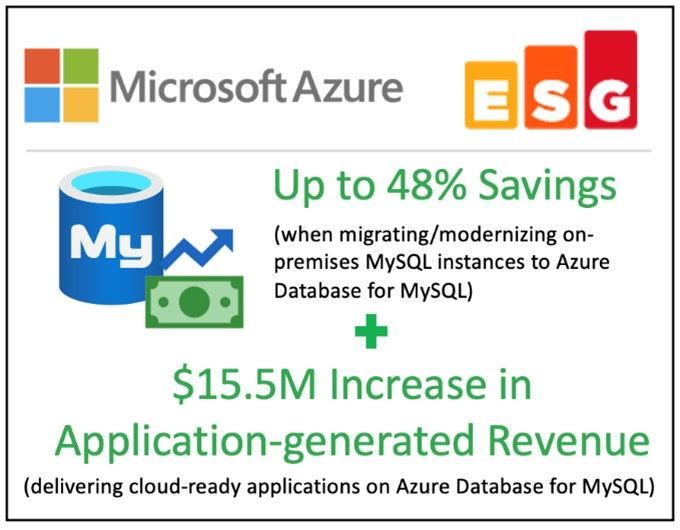
ESG finds that as organizations continue to migrate and modernize to the cloud, they can expect to streamline operations while reducing operational costs and improving business agility with Azure Database for MySQL. Businesses are looking to Microsoft Azure to help digitally transform their applications with more efficient microservice architectures that can be dynamically hosted, scaled, protected, secured, and delivered by the many services provided by the Azure ecosystem. ESG recommends the fully managed Azure Database for MySQL service as a cost-effective solution for successfully increasing business agility, optimizing performance, and maximizing the productivity of developers and IT resources.
For additional detail, refer to ESG’s full report, The Economic Value of Migrating and Modernizing On-premises Instances to Azure Database for MySQL.
If you’re ready to learn more, explore these resources:

by Contributed | Sep 22, 2021 | Technology
This article is contributed. See the original author and article here.
Introduction
This article will show you how to use Azure Synapse (also works with Azure Data Factory) to build a pipeline that gets public data from YouTube using REST API’s and store it in parquet files in ADLS Gen2 and Azure Synapse Analytics. At the end, you should be able to connect to other social media platforms that support REST API’s.
In addition, we will have a look at different ways to analyze the data in Azure Synapse Analytics: using SQL Serverless, SQL Provisioned (SQL Pools) and Spark Clusters.
Considerations
The YouTube REST API calls used in this exercise use API Keys as credentials. Using OAuth 2.0 is not possible because we’re using an automated pipeline that runs without a UI, required for user interaction and sign-in. Managing these credentials is not covered here – please refer to each social media platform API official documentation.
The pipeline stores data in both ADLS Gen2 parquet files and Azure Synapse Analytics SQL Pool tables – this may or may not be a good implementation option. This decision is taken only to be able to demonstrate the two possibilities, between many – obviously, you should consider your own requirements.
What’s needed
Azure Key Vault – to store the API Key; optional but strongly advised.
Azure Synapse Analytics workspace – to build the pipeline (optionally Azure Data Factory can be used)
SQL Serverless – no need to be provision.
SQL Pool – as a provisioned SQL engine; one table and one procedure will be created here.
Spark Cluster – as a provisioned Spark engine to run spark notebooks.
YouTube API Key – to access the YouTube Rest API
1. Preparation
Azure key vault secret
Create a new Azure key vault, or use an existing one, and create a new secret using:
Name: YouTubeMicrosoftDemosProjectAPIKey
Value: <YOUR-YOUTUBE-API-KEY>
Screenshots of getting the API Key value and creating the new secret:


Note: you need to grant the Azure Synapse Analytics workspace Managed Identity access to your Azure Key vault. Learn more here.

In this example, only “Get” and “List” are selected on the “Secret Permissions” list.
Next, open the current version of the secret and store the “Secret Identifier” as it will be used later:

Linked service to the Storage Account
Because we will be using the “Primary” Azure Data Lake Storage Gen2 storage account for the Azure Synapse Analytics workspace, specified when creating the workspace, the linked service is already created, and its name should be in this format: “<WORKSPACE-NAME>-WorkspaceDefaultStorage”.
Note: You need to create a new linked service if you want to use a storage account other than the “Primary” or if you’re using Azure Data Factory.
Linked service to the SQL Pool
Again, there’s no need to create a linked service to a SQL Pool in the same workspace because we will be using an activity that is unique to Azure Synapse Integrate pipelines: the “SQL pool stored procedure”.
Note: If you are using Azure Data Factory, then you need to create a linked service to the SQL Pool where you want to store your data. Refer to the “ADF linked service to Azure Synapse Analytics” section in the Azure Synapse SQL Pools Auto DR article.
Create YouTube video statistics table and related stored procedure
Create a new table in the SQL Pool you want to store the data. It will be used to store some fields from the REST API responses and well as the entire payload.
CREATE TABLE [dbo].[youtube_video_likes] (
ITEM_ID VARCHAR(100) NOT NULL,
VIDEO_ID VARCHAR(100) NOT NULL,
LIKES INT NOT NULL,
FULL_JSON_RESPONSE VARCHAR(MAX) NOT NULL,
TS_INSERT DATETIME NOT NULL
)
WITH (DISTRIBUTION = ROUND_ROBIN, HEAP)
GO
In addition, create a new stored procedure. This will be called to insert the data in the table.
CREATE PROC [dbo].[p_youtube_video_likes_insert] @p_item_id [VARCHAR](100), @p_video_id [varchar](100), @p_likes [INT], @p_full_json_response [VARCHAR](MAX) AS
BEGIN
INSERT INTO [dbo].[youtube_video_likes](item_id, video_id, likes, full_json_response, ts_insert)
SELECT @p_item_id, @p_video_id, @p_likes, @p_full_json_response, SYSDATETIME();
END
GO
2. Create Datasets
We will use the Copy activity to store the REST API responses in parquet files, so we need to create two datasets for the source and sink.
Dataset for source
Create a file and upload it into your storage account. This file is a supporting file as the data we want to store is coming from the REST API calls and not from another file. The content is the simpler JSON snippet we can have, an empty JSON.
Filename |
oneLinerEmpty.JSON |
Content |
{} |
Then, create a new dataset for this file:
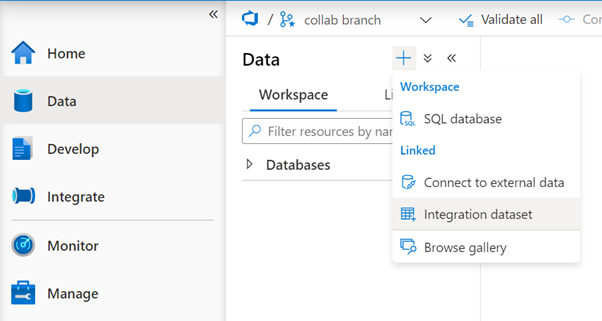


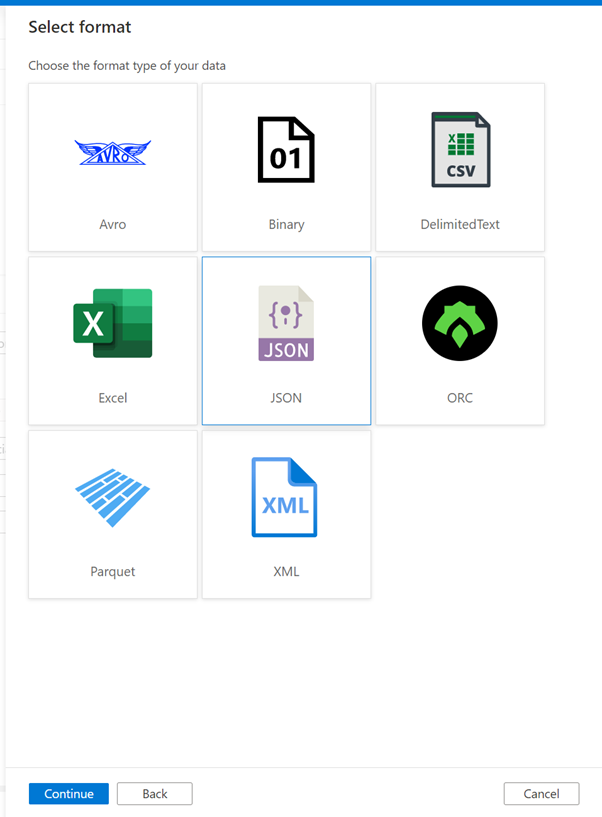
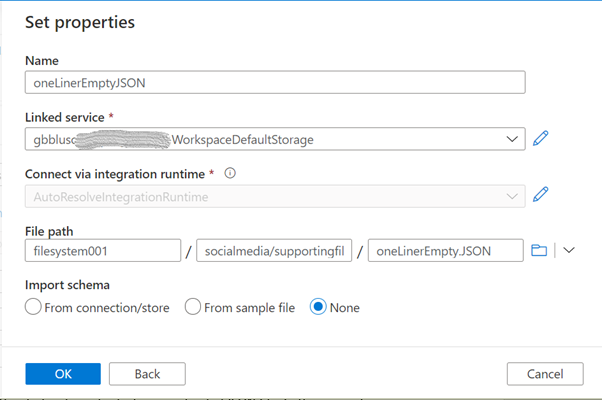
Data store |
Azure Data Lake Storage Gen2 |
Format |
JSON |
Name |
oneLinerEmptyJSON |
Linked service |
the linked service for your “Primary” storage account or another one |
File path |
use the browse button to locate and select your uploaded JSON file. In this example, “filesystem001” is the container name, “socialmedia/supportingfiles” is the folder, and “oneLinerEmpty.JSON” is the file name |
Dataset for sink
Create a new dataset that will be used to store the data in parquet format. This dataset will be parameterized because we will use it to create different files. Follow the same steps as above but select the Parquet format.

Name |
parameterOutputParquet |
Linked service |
the linked service for your “Primary” storage account or another one |
File path |
leave empty as this will be parameterized |
Import schema |
None |
Now it’s time to configure this dataset. In the Parameters tab, create 2 parameters as in this image:
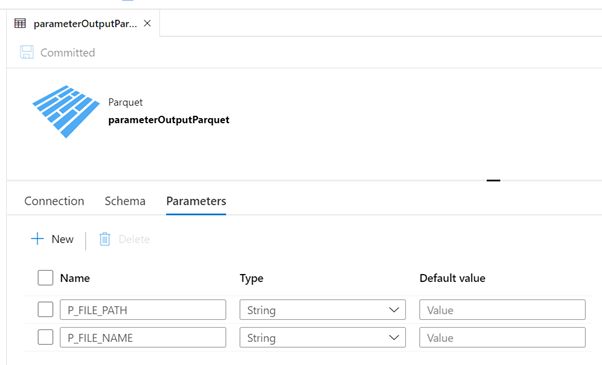
P_FILE_PATH |
String, no default value |
P_FILE_NAME |
String, no default value |
In the Connection tab, we will use these parameters:
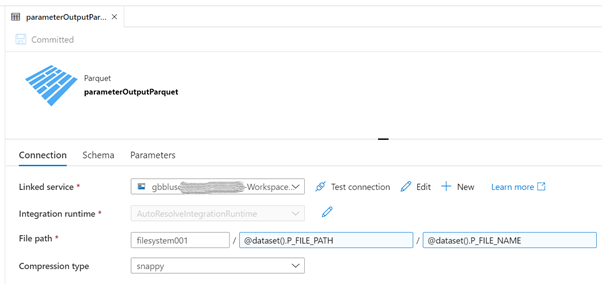
“filesystem001” is the name of the container: Replace accordingly.
Now we are ready to start developing the pipeline.
3. Pipelines
Create an auxiliary pipeline
The first pipeline is the one that uses the 2 datasets we created above and will only have a Copy activity. The objective of this pipeline is to receive a parameter and write that value in a parquet file. It will be called several times from the main pipeline, to store all the REST API responses.
Create a new pipeline, name it “Store Parameter in Parquet File” and create the following parameters, all with type String and no default value:
P_FILE_PATH |
P_FILE_NAME |
P_DATA |

Add a Copy activity, name it “Store parameter P_DATA in Parquet” and configure the Source, Sink and Mapping tabs as shown in the following images.
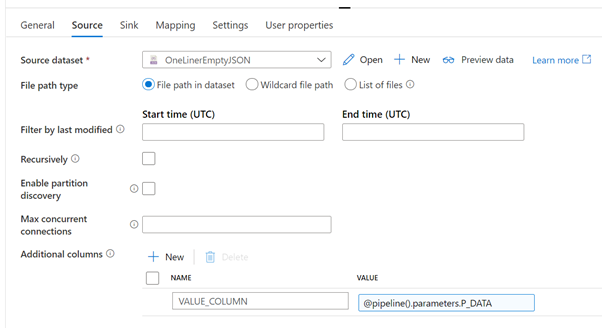
Source dataset |
the JSON file create in the preparation step |
File path type |
File path in dataset |
Recursively |
unchecked |
Additional columns |
create a new column “VALUE_COLUMN” and use the “Add dynamic content” of the VALUE field to add a reference to the parameter P_DATA (@pipeline().parameters.P_DATA).
The goal of this additional column is to create a new column with the content of the received parameter, as if it were read from the input file. This is a way to inject whatever values we want in columns of the Copy activity.
|

Sink dataset |
parameterOutputParquet |
P_FILE_PATH |
@pipeline().parameters.P_FILE_PATH |
P_FILE_NAME |
@pipeline().parameters.P_FILE_NAME |

Map complex values to string |
checked |
Click on the “+ New mapping” to add a new mapping row. Rename the default column name “Column_1” to “VALUE_COLUMN” and map it to the same name in the right side of the mapping.
This pipeline is finished and should look like this:

Create the main pipeline
The main pipeline has these steps:
- Get YouTube API Key from the secret in Azure Key Vault
- Get the playlist ID for a given channel ID
- Get the list of videos for a given playlist ID
- For each video, get video statistics
- Store results in the SQL Pool
In addition, the responses of all 3 YouTube REST API calls will also be stored in parquet files. This will allow us later to look at the data using different analytical/processing engines.
The complete pipeline and parameters will look like this:
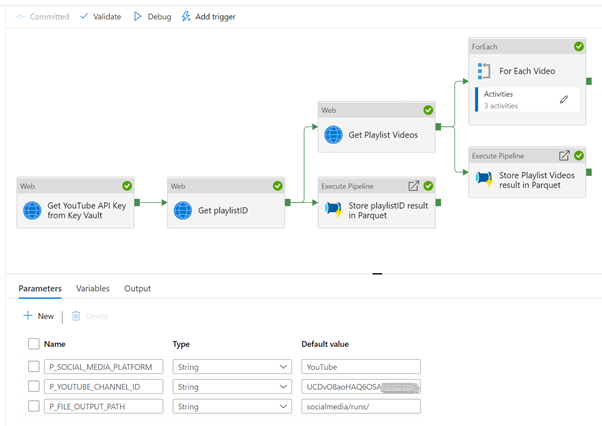
Start by creating a new pipeline, name it “YouTube REST API example with API Key” or whatever you want and add the following parameters and default values:
P_SOCIAL_MEDIA_PLATFORM |
YouTube |
P_YOUTUBE_CHANNEL_ID |
<YOUR-YOUTUBE-API-KEY> |
P_FILE_OUTPUT_PATH |
socialmedia/runs/ |
Add 3 Web activities, link them as shown in the previous picture and configure with the following properties. Only the non-default and important to mention properties are listed.
Web activity 1
The secure output option will hide the results from the API call, in this case it will hide the value we’re getting from the secret, as per the best practices. When we try to look at the result, it looks like this:

To access the value of the secret, we can now use this expression: activity(‘Get YouTube API Key from Key Vault’).output.value
Note: any developer can turn off the secure output option and see the value of the secret. This can happen in a development environment, where the sensitivity is not the same as in a production environment. Make sure that no sensitive information can be seen in a production environment, by including revision rules that validate that no pipelines can be promoted if proper settings for security are not met.
Web activity 2
The secure input option will hide the values sent to this activity, in this case it will hide the API Key used in the URL. If we try to see the runtime input, all we’ll see is this:

We now have the playlist ID for a channel, so we can request a list of videos for that playlist.
Web activity 3
The secure input option is also checked. Notice what we would see if this was not the case:

We want to store the responses of the 2 YouTube REST API calls in parquet format. We already have a pipeline to do that so we will now invoke it.
Add 2 Execute Pipeline activities to the canvas, link them as show in the complete pipeline design and configure as follows.
Execute Pipeline 1
Name |
Store playlistID result in Parquet |
Invoked pipeline |
Store Parameter in Parquet File, or any other name you gave to the auxiliary pipeline |
Wait on completion |
checked |
P_FILE_PATH |
@concat(
pipeline().parameters.P_FILE_OUTPUT_PATH,
pipeline().parameters.P_SOCIAL_MEDIA_PLATFORM
) |
P_FILE_NAME |
@concat(
‘getPlaylistID-‘,
utcnow(),
‘.parquet’
) |
P_DATA |
@string(activity(‘Get playlistID’).output) |
This activity will store the REST API response in a parquet file in the storage account. The file name will be similar to “getPlaylistID-2021-04-23T13:13:19.4426957Z.parquet”.
Execute Pipeline 2
Name |
Store Playlist Videos result in Parquet |
Invoked pipeline |
Store Parameter in Parquet File, or any other name you gave to the auxiliary pipeline |
Wait on completion |
checked |
P_FILE_PATH |
@concat(
pipeline().parameters.P_FILE_OUTPUT_PATH,
pipeline().parameters.P_SOCIAL_MEDIA_PLATFORM
) |
P_FILE_NAME |
@concat(
‘getPlaylistVideos-‘,
utcnow(),
‘.parquet’
) |
P_DATA |
@string(activity(‘Get Playlist Videos’).output) |
This activity will store the REST API response in a parquet file in the storage account. The file name will be similar to “getPlaylistVideos-2021-04-23T13:13:22.3769063Z.parquet”.
Now that we have a list of videos, we need to get the statistics for each one of them. To accomplish that, we add a ForEach activity to the pipeline, connect it to the output of the “Get Playlist Videos” activity and configure as:
Name |
For Each Video |
Sequential |
checked, but can also run in parallel |
Items |
@activity(‘Get Playlist Videos’).output.items |
Next, we add the remaining activities inside the loop, that will run for each video in the playlist. At the end it will look like this:
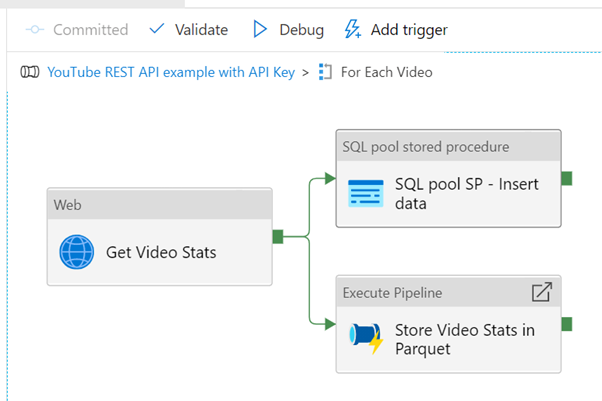
Web activity
This activity will request some statistics for a given video. Statistics include the number of views, likes, comments, and so on.
Execute pipeline activity
Name |
Store Video Stats in Parquet |
Invoked pipeline |
Store Parameter in Parquet File, or any other name you gave to the auxiliary pipeline |
Wait on completion |
checked |
P_FILE_PATH |
@concat(
pipeline().parameters.P_FILE_OUTPUT_PATH,
pipeline().parameters.P_SOCIAL_MEDIA_PLATFORM
) |
P_FILE_NAME |
@concat(
‘getVideoStats-‘,
utcnow(),
‘.parquet’
) |
P_DATA |
@string(activity(‘Get Video Stats’).output) |
This activity will store the REST API response in a parquet file in the storage account. The file name will be similar to “getVideoStats-2021-04-23T13:13:25.6924926Z.parquet”.
SQL Pool Stored Procedure
Name |
SQL pool SP – Insert data |
Azure Synapse dedicated SQL pool |
select the SQL pool where you created the table and stored procedure |
Stored procedure name |
[dbo].[p_youtube_video_likes_insert], or whatever you called it |
Stored procedure parameters (use the import button to list them):
p_item_id |
@item().id |
p_video_id |
@item().snippet.resourceId.videoId |
p_likes |
@activity(‘Get Video Stats’).output.items[0].statistics.likeCount |
p_full_json_response |
@string(activity(‘Get Video Stats’).output) |
The call to the stored procedure will make sure that some individual fields (item id, video id, count of likes) as well as the full response are stored in a table in a SQL pool. In a real scenario, we would need to create a model to hold the data, as per the requirements.
Note: if you use Azure Data Factory, the same goal can be achieved using the “Stored procedure” activity, but you would need to use a linked service to the target SQL pool.
We can now run the full pipeline and validate that several files were created in the storage account and some data inserted in the SQL pool table.
4. Look at the data
Because we stored our data in parquet files and tables in a SQL pool, we have several options to use to manipulate the data.
This table summarizes some of the options using Azure Synapse Analytics:
|
Data format and store |
Compute options |
Parquet files in ADLS Gen2 |
Tables in SQL Pools |
SQL Serverless
|
Y (*)
|
N
|
SQL Provisioned
|
Y
|
Y (*)
|
Spark Cluster
|
Y (*)
|
Y
|
Below we will look at short examples of the options marked with (*). The goal is not to go deep into technical details of JSON handling but rather have an idea of the possibilities to use.
a) SQL Serverless on Parquet files in ADLS Gen2
We can use the OPENROWSET function to read a parquet file and show its contents.
-- check file as-is
SELECT * FROM OPENROWSET(
BULK 'https://mydatalake.dfs.core.windows.net/filesystem001/socialmedia/runs/YouTube/getVideoStats-2021-04-23T12:37:12.2853807Z.parquet',
FORMAT='PARQUET'
) AS [result]

Since we have a JSON file, we can take advantage of the OPENJSON function to parse the elements in the first level of the file.
-- OPENJSON in action
SELECT [key], [value], [type]
FROM OPENROWSET(
BULK 'https://mydatalake.dfs.core.windows.net/filesystem001/socialmedia/runs/YouTube/getVideoStats-2021-04-23T12:37:12.2853807Z.parquet',
FORMAT='PARQUET'
) as [result2]
CROSS APPLY OPENJSON(VALUE_COLUMN)
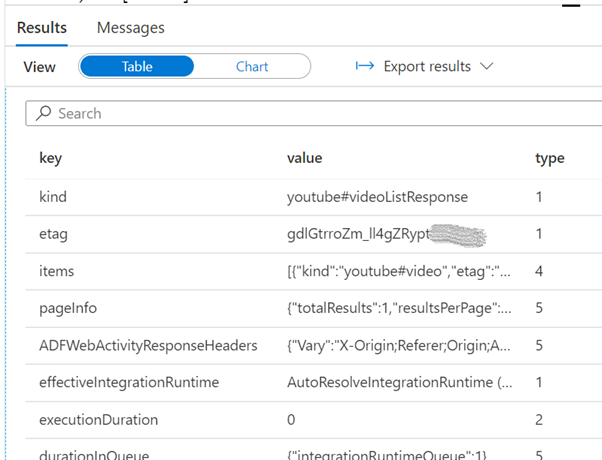
You can read more about OPENROWSET and OPENJSON here:
b) SQL Provisioned on Tables in SQL Pools
OPENJSON is also available on the SQL Provisioned engine.
-- check data as-is
SELECT *, isjson(full_json_response) as 'IS_JSON'
FROM [dbo].[youtube_video_likes]
GO

SELECT *
FROM [dbo].[youtube_video_likes]
cross apply openjson(full_json_response)
where video_id = 'A212x5XXXXX'
GO

You can read more about OPENJSON for SQL Provisioned and JSON functions here:
c) Spark Cluster on Parquet files in ADLS Gen2
We can also use a Spark Cluster as a Spark processing engine to look at the data.
For this task, we create a new notebook. By default, the selected language is Python (Spark) and we can leave it like that, although we can use different languages by using Cell Magic Commands like %%pyspark or %%sql. We also need to attach the notebook to an existing Apache Spark Pool.
First, we load the data into a dataframe:
%%pyspark
df = spark.read.load('abfss://filesystem001@mydatalake.dfs.core.windows.net/socialmedia/runs/YouTube/getVideoStats-2021-04-23T12:37:12.2853807Z.parquet', format='parquet')
display(df)

Since we have the data in a dataframe, we can use pyspark to manipulate the data:
%%pyspark
from pyspark.sql.functions import from_json, col
from pyspark.sql.types import StructType, StructField, StringType, ArrayType
statistics_schema = StructType([
StructField('likeCount', StringType(), True)
])
items_schema = StructType([
StructField('id', StringType(), True),
StructField('statistics', statistics_schema, True)
])
schema = StructType([
StructField('kind', StringType(), True),
StructField('etag', StringType(), True),
StructField('items', ArrayType(items_schema), True)
])
display(
df.withColumn('kind', from_json(col('VALUE_COLUMN'), schema).getItem('kind'))
.withColumn('etag', from_json(col('VALUE_COLUMN'), schema).getItem('etag'))
.withColumn('video_id', from_json(col('VALUE_COLUMN'), schema).getItem('items')[0].getItem('id'))
.withColumn('likes', from_json(col('VALUE_COLUMN'), schema).getItem('items')[0].getItem('statistics').getItem('likeCount'))
.select('kind', 'etag', 'video_id', 'likes')
)

If SQL is the preferred way, we can create a table from the dataframe and use the get_json_object function to parse the json strings:
%%pyspark
df.write.mode("overwrite").saveAsTable("default.youtube_video_likes")

%%sql
SELECT get_json_object(VALUE_COLUMN, '$.kind') as `kind`,
get_json_object(VALUE_COLUMN, '$.etag') as `etag`,
get_json_object(VALUE_COLUMN, '$.items[0].id') as `videoId`,
get_json_object(VALUE_COLUMN, '$.items[0].statistics.likeCount') as `likes`
FROM default.youtube_video_likes

Summary
It is easy to build an Azure Synapse Pipeline that gets information from social media.
In the example shown in this article, on how to get some data from YouTube, we covered the ingestion, storing and consumption using different techniques, and more can be used. There is not “the correct” way to do it but rather a way that makes sense in your environment.
You can find all the code in the attachment file below, including the pipelines and datasets, SQL scripts, notebooks and supporting files, as well as on GitHub under the repository name SynapseIntegrateSocialMedia.
by Scott Muniz | Sep 22, 2021 | Security, Technology
This article is contributed. See the original author and article here.
Summary
Immediate Actions You Can Take Now to Protect Against Conti Ransomware
• Use multi-factor authentication.
• Segment and segregate networks and functions.
• Update your operating system and software.
Note: This Alert uses the MITRE Adversarial Tactics, Techniques, and Common Knowledge (ATT&CK®) framework, version 9. See the ATT&CK for Enterprise for all referenced threat actor tactics and techniques.
The Cybersecurity and Infrastructure Security Agency (CISA) and the Federal Bureau of Investigation (FBI) have observed the increased use of Conti ransomware in more than 400 attacks on U.S. and international organizations. In typical Conti ransomware attacks, malicious cyber actors steal files, encrypt servers and workstations, and demand a ransom payment.
To secure systems against Conti ransomware, CISA, FBI, and the National Security Agency (NSA) recommend implementing the mitigation measures described in this Advisory, which include requiring multi-factor authentication (MFA), implementing network segmentation, and keeping operating systems and software up to date.
Click here for a PDF version of this report.
Click here for indicators of compromise (IOCs) in STIX format.
Technical Details
While Conti is considered a ransomware-as-a-service (RaaS) model ransomware variant, there is variation in its structure that differentiates it from a typical affiliate model. It is likely that Conti developers pay the deployers of the ransomware a wage rather than a percentage of the proceeds used by affiliate cyber actors and receives a share of the proceeds from a successful attack.
Conti actors often gain initial access [TA0001] to networks through:
- Spearphishing campaigns using tailored emails that contain malicious attachments [T1566.001] or malicious links [T1566.002];
- Malicious Word attachments often contain embedded scripts that can be used to download or drop other malware—such as TrickBot and IcedID, and/or Cobalt Strike—to assist with lateral movement and later stages of the attack life cycle with the eventual goal of deploying Conti ransomware. [1],[2],[3]
- Stolen or weak Remote Desktop Protocol (RDP) credentials [T1078].[4]
- Phone calls;
- Fake software promoted via search engine optimization;
- Other malware distribution networks (e.g., ZLoader); and
- Common vulnerabilities in external assets.
In the execution phase [TA0002], actors run a getuid payload before using a more aggressive payload to reduce the risk of triggering antivirus engines. CISA and FBI have observed Conti actors using Router Scan, a penetration testing tool, to maliciously scan for and brute force [T1110] routers, cameras, and network-attached storage devices with web interfaces. Additionally, actors use Kerberos attacks [T1558.003] to attempt to get the Admin hash to conduct brute force attacks.
Conti actors are known to exploit legitimate remote monitoring and management software and remote desktop software as backdoors to maintain persistence [TA0003] on victim networks.[5] The actors use tools already available on the victim network—and, as needed, add additional tools, such as Windows Sysinternals and Mimikatz—to obtain users’ hashes and clear-text credentials, which enable the actors to escalate privileges [TA0004] within a domain and perform other post-exploitation and lateral movement tasks [TA0008]. In some cases, the actors also use TrickBot malware to carry out post-exploitation tasks.
According to a recently leaked threat actor “playbook,” [6] Conti actors also exploit vulnerabilities in unpatched assets, such as the following, to escalate privileges [TA0004] and move laterally [TA0008] across a victim’s network:
- 2017 Microsoft Windows Server Message Block 1.0 server vulnerabilities; [7]
- “PrintNightmare” vulnerability (CVE-2021-34527) in Windows Print spooler [8] service; and
- “Zerologon” vulnerability (CVE-2020-1472) in Microsoft Active Directory Domain Controller systems.[9]
Artifacts leaked with the playbook identify four Cobalt Strike server Internet Protocol (IP) addresses Conti actors previously used to communicate with their command and control (C2) server.
162.244.80[.]23585.93.88[.]165185.141.63[.]12082.118.21[.]1
CISA and FBI have observed Conti actors using different Cobalt Strike server IP addresses unique to different victims.
Conti actors often use the open-source Rclone command line program for data exfiltration [TA0010]. After the actors steal and encrypt the victim’s sensitive data [T1486], they employ a double extortion technique in which they demand the victim pay a ransom for the release of the encrypted data and threaten the victim with public release of the data if the ransom is not paid.
MITRE ATT&CK Techniques
Conti ransomware uses the ATT&CK techniques listed in table 1.
Table 1: Conti ATT&CK techniques for enterprise
| Technique Title |
ID |
Use |
| Valid Accounts |
T1078 |
Conti actors have been observed gaining unauthorized access to victim networks through stolen Remote Desktop Protocol (RDP) credentials. |
| Phishing: Spearphishing Attachment |
T1566.001 |
Conti ransomware can be delivered using TrickBot malware, which is known to use an email with an Excel sheet containing a malicious macro to deploy the malware. |
| Phishing: Spearphishing Link |
T1566.002 |
Conti ransomware can be delivered using TrickBot, which has been delivered via malicious links in phishing emails. |
| Technique Title |
ID |
Use |
| Command and Scripting Interpreter: Windows Command Shell |
T1059.003 |
Conti ransomware can utilize command line options to allow an attacker control over how it scans and encrypts files. |
| Native Application Programming Interface (API) |
T1106 |
Conti ransomware has used API calls during execution. |
| Technique Title |
ID |
Use |
| Valid Accounts |
T1078 |
Conti actors have been observed gaining unauthorized access to victim networks through stolen RDP credentials. |
| External Remote Services |
T1133 |
Adversaries may leverage external-facing remote services to initially access and/or persist within a network. Remote services such as virtual private networks (VPNs), Citrix, and other access mechanisms allow users to connect to internal enterprise network resources from external locations. There are often remote service gateways that manage connections and credential authentication for these services. Services such as Windows Remote Management can also be used externally. |
| Technique Title |
ID |
Use |
| Process Injection: Dynamic-link Library Injection |
T1055.001 |
Conti ransomware has loaded an encrypted dynamic-link library (DLL) into memory and then executes it. |
| Technique Title |
ID |
Use |
| Obfuscated Files or Information |
T1027 |
Conti ransomware has encrypted DLLs and used obfuscation to hide Windows API calls. |
| Process Injection: Dynamic-link Library Injection |
T1055.001 |
Conti ransomware has loaded an encrypted DLL into memory and then executes it. |
| Deobfuscate/Decode Files or Information |
T1140 |
Conti ransomware has decrypted its payload using a hardcoded AES-256 key. |
| Technique Title |
ID |
Use |
| Brute Force |
T1110 |
Conti actors use legitimate tools to maliciously scan for and brute force routers, cameras, and network-attached storage devices with web interfaces. |
| Steal or Forge Kerberos Tickets: Kerberoasting |
T1558.003 |
Conti actors use Kerberos attacks to attempt to get the Admin hash. |
| System Network Configuration Discovery |
T1016 |
Conti ransomware can retrieve the ARP cache from the local system by using the GetIpNetTable() API call and check to ensure IP addresses it connects to are for local, non-internet systems. |
| System Network Connections Discovery |
T1049 |
Conti ransomware can enumerate routine network connections from a compromised host. |
| Process Discovery |
T1057 |
Conti ransomware can enumerate through all open processes to search for any that have the string sql in their process name. |
| File and Directory Discovery |
T1083 |
Conti ransomware can discover files on a local system. |
| Network Share Discovery |
T1135 |
Conti ransomware can enumerate remote open server message block (SMB) network shares using NetShareEnum(). |
| Technique Title |
ID |
Use |
| Remote Services: SMB/Windows Admin Shares |
T1021.002 |
Conti ransomware can spread via SMB and encrypts files on different hosts, potentially compromising an entire network. |
| Taint Shared Content |
T1080 |
Conti ransomware can spread itself by infecting other remote machines via network shared drives. |
| Technique Title |
ID |
Use |
| Data Encrypted for Impact |
T1486 |
Conti ransomware can use CreateIoCompletionPort(), PostQueuedCompletionStatus(), and GetQueuedCompletionPort() to rapidly encrypt files, excluding those with the extensions of .exe, .dll, and .lnk. It has used a different AES-256 encryption key per file with a bundled RAS-4096 public encryption key that is unique for each victim. Conti ransomware can use “Windows Restart Manager” to ensure files are unlocked and open for encryption. |
| Service Stop |
T1489 |
Conti ransomware can stop up to 146 Windows services related to security, backup, database, and email solutions through the use of net stop. |
| Inhibit System Recovery |
T1490 |
Conti ransomware can delete Windows Volume Shadow Copies using vssadmin. |
Mitigations
CISA, FBI, and NSA recommend that network defenders apply the following mitigations to reduce the risk of compromise by Conti ransomware attacks.
Use multi-factor authentication.
Implement network segmentation and filter traffic.
- Implement and ensure robust network segmentation between networks and functions to reduce the spread of the ransomware. Define a demilitarized zone that eliminates unregulated communication between networks.
- Filter network traffic to prohibit ingress and egress communications with known malicious IP addresses.
- Enable strong spam filters to prevent phishing emails from reaching end users. Implement a user training program to discourage users from visiting malicious websites or opening malicious attachments. Filter emails containing executable files to prevent them from reaching end users.
- Implement a URL blocklist and/or allowlist to prevent users from accessing malicious websites.
Scan for vulnerabilities and keep software updated.
- Set antivirus/antimalware programs to conduct regular scans of network assets using up-to-date signatures.
- Upgrade software and operating systems, applications, and firmware on network assets in a timely manner. Consider using a centralized patch management system.
Remove unnecessary applications and apply controls.
- Remove any application not deemed necessary for day-to-day operations. Conti threat actors leverage legitimate applications—such as remote monitoring and management software and remote desktop software applications—to aid in the malicious exploitation of an organization’s enterprise.
- Investigate any unauthorized software, particularly remote desktop or remote monitoring and management software.
- Implement application allowlisting, which only allows systems to execute programs known and permitted by the organization’s security policy. Implement software restriction policies (SRPs) or other controls to prevent programs from executing from common ransomware locations, such as temporary folders supporting popular internet browsers or compression/decompression programs.
- Implement execution prevention by disabling macro scripts from Microsoft Office files transmitted via email. Consider using Office Viewer software to open Microsoft Office files transmitted via email instead of full Microsoft Office suite applications.
- See the joint Alert, Publicly Available Tools Seen in Cyber Incidents Worldwide—developed by CISA and the cybersecurity authorities of Australia, Canada, New Zealand, and the United Kingdom—for guidance on detection and protection against malicious use of publicly available tools.
Implement endpoint and detection response tools.
- Endpoint and detection response tools allow a high degree of visibility into the security status of endpoints and can help effectively protect against malicious cyber actors.
Limit access to resources over the network, especially by restricting RDP.
- After assessing risks, if RDP is deemed operationally necessary, restrict the originating sources and require multi-factor authentication.
Secure user accounts.
- Regularly audit administrative user accounts and configure access controls under the principles of least privilege and separation of duties.
- Regularly audit logs to ensure new accounts are legitimate users.
Review CISA’s APTs Targeting IT Service Provider Customers guidance for additional mitigations specific to IT Service Providers and their customers.
Use the Ransomware Response Checklist in case of infection.
If a ransomware incident occurs at your organization, CISA, FBI, and NSA recommend the following actions:
CISA, FBI, and NSA strongly discourage paying a ransom to criminal actors. Paying a ransom may embolden adversaries to target additional organizations, encourage other criminal actors to engage in the distribution of ransomware, and/or may fund illicit activities. Paying the ransom also does not guarantee that a victim’s files will be recovered.
Additional Resources
Free Cyber Hygiene Services
CISA offers a range of no-cost cyber hygiene services to help organizations assess, identify, and reduce their exposure to threats, including ransomware. By requesting these services, organizations of any size could find ways to reduce their risk and mitigate attack vectors.
StopRansomware.gov
The StopRansomware.gov webpage is an interagency resource that provides guidance on ransomware protection, detection, and response. This includes ransomware alerts, reports, and resources from CISA and other federal partners, including:
Rewards for Justice Reporting
The U.S. Department of State’s Rewards for Justice (RFJ) program offers a reward of up to $10 million for reports of foreign government malicious activity against U.S. critical infrastructure. See the RFJ website for more information and how to report information securely.
Contact Information
To report suspicious or criminal activity related to information found in this Joint Cybersecurity Advisory, contact your local FBI field office at www.fbi.gov/contact-us/field-offices, or the FBI’s 24/7 Cyber Watch (CyWatch) at (855) 292-3937 or by e-mail at CyWatch@fbi.gov. When available, please include the following information regarding the incident: date, time, and location of the incident; type of activity; number of people affected; type of equipment used for the activity; the name of the submitting company or organization; and a designated point of contact. If you have any further questions related to this Joint Cybersecurity Advisory, or to request incident response resources or technical assistance related to these threats, contact CISA at CISAServiceDesk@cisa.dhs.gov. For NSA client requirements or general cybersecurity inquiries, contact the NSA Cybersecurity Requirements Center at 410-854-4200 or Cybersecurity_Requests@nsa.gov.
References
Revisions
September 22, 2021: Initial Version
This product is provided subject to this Notification and this Privacy & Use policy.




































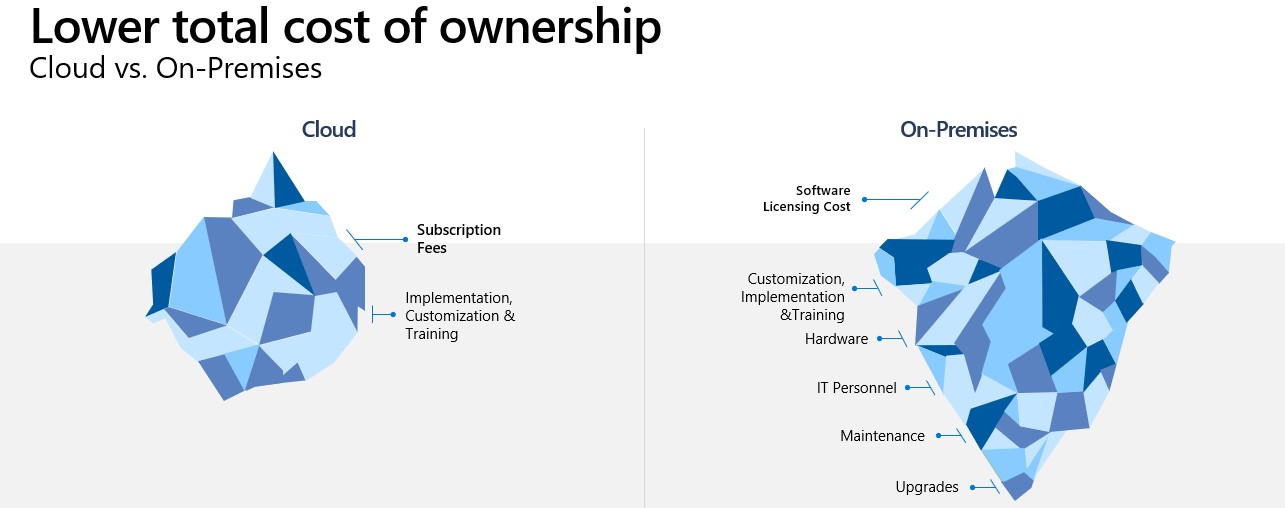
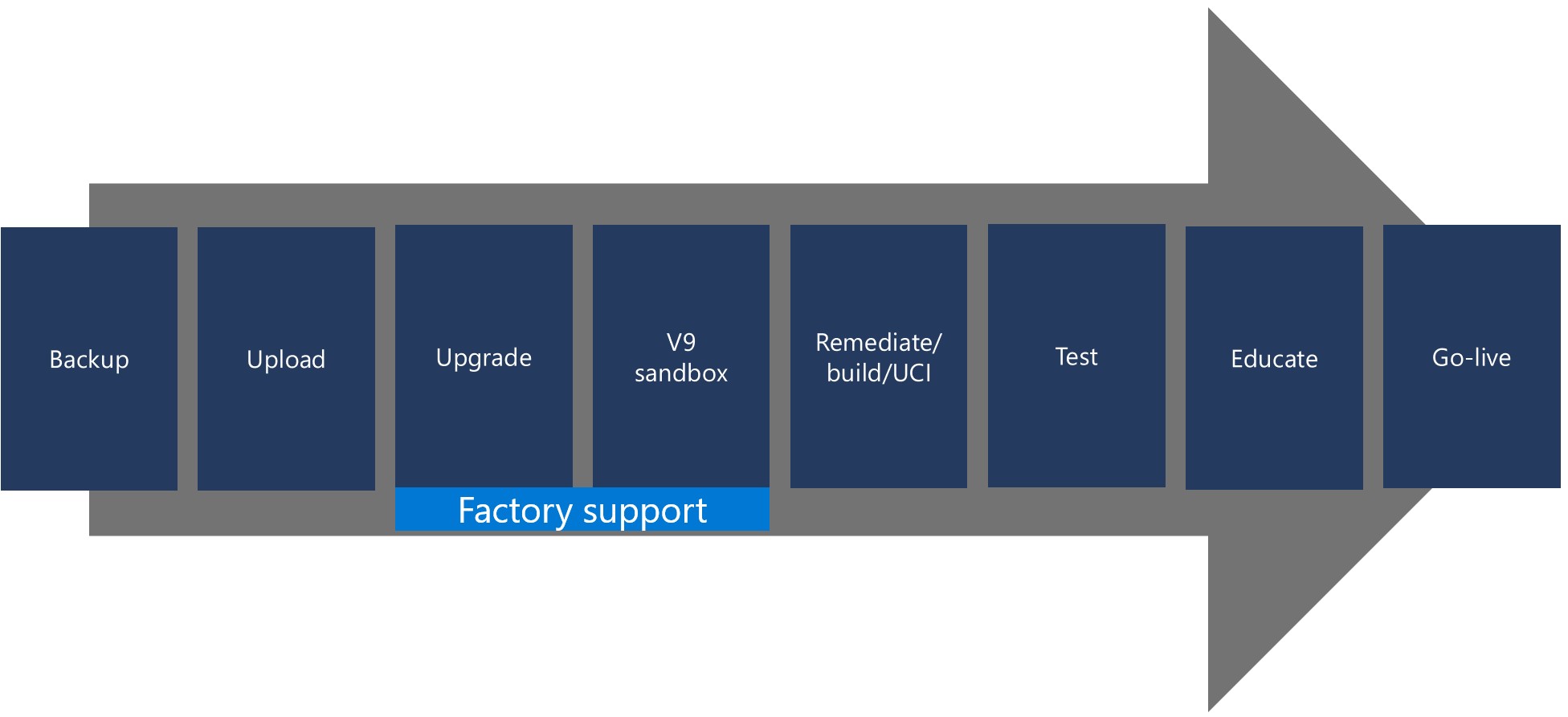


Recent Comments